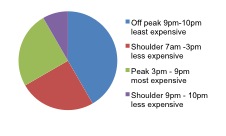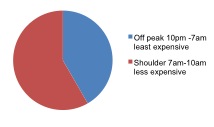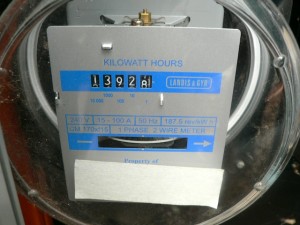 Roberta is a classic A type personality.
Roberta is a classic A type personality.
Hitting the kitchen with the jitters after a nauseating day, she opens the fridge desperate for anything that will raise her blood sugar levels.
“Hello Roberta, how was work”?
“Ghastly,” she replies.
“There’s that last chocolate éclair on the top shelf,” the smart fridge says taking on a comforting role. “Eating that should take the edge off things. Umm..I know that it’s not the best time to bring this up but you put on a couple of kilos last week so maybe éclairs should be left off next week’s shopping list.”
We are deep in the world of smart technology, which is radically altering everyday communication and replacing the need for humans in an increasing number of traditional roles.
One of the technological feats is the Smart Meter at the heart of the smart grid. It has been hailed by some as an ‘environmental saviour of the future’ at a time when the world is crying out for one. Yet is this little gray box something to be embraced? Or does it come at a cost that is too high?
In Australia, the people of Victoria were given no choice but to accept smart meters; Italians have paid very high tariffs since their rollout, yet a small sample in the UK say they love them.
What are the financial costs or benefits to NSW of ‘smarting up’? With a decision on a meter rollout pending it is time for an open debate on the issue.
The smart meter is the creation of Eric Beattie, an electronically savvy chartered engineer from Scotland who has more than 30 years of experience under his belt. Its initial function was to enable consumers to top up their prepaid energy meters remotely. Mr Beattie received a European Smart Meter of the Year award for this wireless technology, unaware that it would ferment deep disagreement in countries and communities worldwide.
Smart is a seemingly appropriate prefix for this new digital meter that allows both the consumer and the utility company to monitor individual energy usage via two or more radio transmitters. The data available can then be accessed remotely.
The idea is for the consumer to take charge. Using the data from the smart device and making use of the flexible pricing offered by the utilities, an individual customer can choose when to run appliances and manage household energy costs.
Ausgrid, one of the energy distributors responsible for meter rollouts, recommends ways to make “savings with time of use pricing”. The emphasis with the Smart Meters, it informs, is not really on increased energy efficiency but in a shift of usage time so that costs can be lowered.
In favour of the technology, the NSW Greens believe it will also encourage energy conservation.
Jamie Parker, Greens MP for Balmain, said: “By giving the householder more information about their power consumption, including when the grid is under pressure and power will be more expensive, smart meters can be an effective tool to reduce power usage. Change in user habits will allow more sustainable, low-carbon electricity systems like wind and solar to take over from traditional fossil fuels.”
So far, so good.The consumer can save on energy bills and help the planet’s future at the same time.
Keith Higgins doesn’t see it this way. Higgins is a former Mount Druitt TAFE College lecturer and inventor of the energy saving LED lights that he introduced in the ABC’s New Inventors program in 2007. He views the new meters as a way of increasing revenue for the electricity suppliers with support from the markets. Energy will cost more during peak periods, in off-peak hours less with the installation of a smart meter. Even with this type of flexible pricing in place though says Mr Higgins, “smart people can outsmart smart metres”.
An example of the flexible pricing structure electricity companies are likely to offer is shown on the Victorian government smart meter website where it is seen that peak rates are charged during the day when most gadgets are used and off-peak rates at night.
Example of pricing structure based on Victorian Government website; Illustrative only.
To help the consumer navigate this problem the Victorian state government has offered tools like ‘my power planner’ and templates from independent sites to calculate cost options. Flat or flexible electricity pricing available in the state from this year allows individual homes or business the option to choose.
Independent consumer advocate Choice welcomed the information.
“Smart meters provide consumers with more innovative electricity products that allow them to have more control of their electricity use and costs,” said a spokeswoman from Energy Australia, Victoria.
Meanwhile, on the ground in Victoria, Sharka Kulic, who until recently has been living peacefully in a leafy green Victorian street, is completely opposed to the new meters.
“It has so far cost Victorian taxpayers over 2.4 billion dollars and EVERYONE in Victoria is seeing bills double! I have not heard one person say ‘wow my electricity bills are so much lower’ especially now that we have a smart meter,” she said.
Sharka has been spending an enormous amount of time and energy to hold on to her old analogue meter.
“Over 75,000 people in Victoria are protesting against having a smart meter,” she said. “Our electricity is basically no longer owned by Australia but by Hong Kong companies and of course they are there for profit, profit, profit.”
Hong Kong-based companies Cheung Kong Infrastructure Limited and Power Asset Holdings hold major stakes in the electricity distribution networks in the state of Victoria, which required a major overhaul of its infrastructure to accommodate the new technology. This has been financed by the taxpayer.
Sharka said she would love to have a business that was upgraded at the taxpayers’ expense.
Mark Henley, an Energy Advocate from UnitingCare Australia based in South Australia, indicated that during the mandatory rollout Victorians had paid $1000 per meter, but that meter costs had fallen to about $300-$400 by February this year.
“Of course the customer always pays,” Mr Henley said.
The Frontier Economics 2012 paper Smart metering? Dumb solution, reported that a rollout of smart meters would add an average of over $100 a year to the amount customers will pay, on top of all the other increases.
“Victorians will be worse off to the tune of $300 million in net terms – that is, even allowing for all the presumed future benefits from reducing peak demand and eliminating human meter readers, ” it calculated.
The sophisticated meter technology itself comes at a price. A Smart Meter costs approximately $100-$200 compared to a traditional meter cost of $15- $35. Read costs are estimated to rise four-to-tenfold with the new energy device, without ‘data management and infrastructure services’ included. These figures were supplied by Ausgrid in February 2014 from the infographic Your Power, Your Say Facebook page.
The smart meter has been shown to be less economical electricity-wise compared to the traditional analogue meters, said Sharka.
In South Australia consumers are to be given the option of whether or not to install a smart meter according to South Australian Energy Minister Tom Koutsantonis.
“We want to give South Australians a choice, so under this households can opt out and have a regular meter installed or have a smart-ready meter, yet choose not to take up the smart meter products and services,” Minister Koutsantonis said.
Mr Higgins is all for using energy storage batteries. They can be charged during low cost energy periods and then used to run electrical devices during the day when costs are at a premium, he advises.
Great idea but how many would really set up such a system, even for financial advantage?
According to Higgins, not many.
“The real problem is that people are generally loath to change. Consumers tend not to calculate their energy usage or willingly change their energy usage habits,” he said.
“Look at the findings of companies who choose to give, say $10 cash back as an incentive to buy, rather than offering a straight $10 discount at the time. They show that on average only 20 per cent of customers will make the effort to claim the money back later.”
Now to the really bizarre: reactive currents. The traditional analogue meters don’t measure unused energy discharged onto powerlines. However, the electronic smart ones do, registering “other parameters such as power factor and reactive power”. So “if a home has ground electrical currents on its metal water pipes” for example–and how many have the foggiest idea about those–the quarterly household electricity bill may include considerable extra costs that bear no relation to personal energy usage.
So is the smart meter a smart choice?
Even disregarding considerable publically-funded rollout costs, unless the consumer is prepared to radically change electricity usage habits–put the washing on at night, rig up a system that allows cheaper energy use during the day, stop using some smart gadgets, or just become very green– it will be the energy suppliers and smart meter distributors, not the customers, who are laughing all the way to financial benefit.







